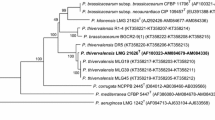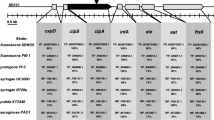Abstract
Aspergillus nidulans produces two major siderophores: it excretes triacetylfusarinine C to capture iron and contains ferricrocin as an intracellular iron-storage compound. Siderophore biosynthesis involves the enzymatic activity of nonribosomal peptide synthetases (NRPS). NRPS contain 4′-phosphopantetheine as an essential prosthetic group, which is attached by 4′-phosphopantetheinyl transferases. A. nidulans appears to possess at least one gene, npgA, encoding such an enzyme. Using a strain carrying a temperature-sensitive allele, cfwA2, we showed that NpgA is essential for biosynthesis of both the peptide bond-containing ferricrocin and the ester bond-containing triacetylfusarinene C. The cfwA2 strain was found to be iron-starved at the restrictive temperature during iron-replete conditions, consistent with the siderophore system being the major iron-uptake system—as we recently demonstrated. Northern analysis indicated that, in contrast to other genes which are involved in siderophore biosynthesis and uptake, expression of npgA is not controlled by the GATA-transcription factor SreA. It was shown previously that NpgA is required for biosynthesis of penicillin, pigment, and potentially lysine via the α-aminoadipate pathway. Supplementation with lysine plus triacetylfusarinine C restored normal growth of the cfwA2 strain at the restrictive temperature, suggesting that the growth defect of the mutant is mainly due to impaired biosynthesis of siderophores and lysine.




Similar content being viewed by others
References
Aguirre J, Ortiz R, Clutterbuck J, Tapia R, Cardenas M (1993) vegA and cfwA define two new developmental genes in Aspergillus nidulans. Fungal Genet Newsl 40a:68
Arst HN Jr, Scazzocchio C, Kristensen T (1973) A locus specific lysine repressor in Aspergillus nidulans. Heredity 31:429
Brookman JL, Denning DW (2000) Molecular genetics in Aspergillus fumigatus. Curr Opin Microbiol 3:468–474
Busch S, Bode HB, Brakhage AA, Braus GH (2003) Impact of the cross-pathway control on the regulation of lysine and penicillin biosynthesis in Aspergillus nidulans. Curr Genet 42:209–219
Charlang G, Ng B, Horowitz NH, Horowitz RM (1981) Cellular and extracellular siderophores of Aspergillus nidulans and Penicillium chrysogenum. Mol Cell Biol 1:94–100
Chung YS, Chae K-S, Han DM, Jahng K-Y (1996) Chemical composition and structure of hyphal wall of null-pigment mutants of Aspergillus nidulans. Mol Cells 6:731–736
Crosa JH, Walsh CT (2002) Genetics and assembly line enzymology of siderophore biosynthesis in bacteria. Microbiol Mol Biol Rev 66:223–249
Ehmann DE, Gehring AM, Walsh CT (1999) Lysine biosynthesis in Saccharomyces cerevisiae: mechanism of alpha-aminoadipate reductase (Lys2) involves posttranslational phosphopantetheinylation by Lys5. Biochemistry 38:6171–6177
Eisendle M, Oberegger H, Zadra I, Haas H (2003) The siderophore system is essential for viability of Aspergillus nidulans: functional analysis of two genes encoding l-ornithine N 5-monooxygenase (sidA) and a nonribosomal peptide synthetase (sidC). Mol Microbiol 49:359–375
Fidel S, Doonan JH, Morris NR (1988) Aspergillus nidulans contains a single actin gene which has unique intron locations and encodes a gamma-actin. Gene 70:283–293
Finking R, Solsbacher J, Konz D, Schobert M, Schäfer A, Jahn D, Marahiel A (2002) Characterization of a new type of phosphopantetheinyl transferase for fatty acid and siderophore synthesis in Pseudomonas aeruginosa. J Biol Chem 277:50293–50302
Guerinot ML (1994) Microbial iron transport. Annu Rev Microbiol 48:743–772
Haas H (2003) Molecular genetics of fungal siderophore biosynthesis and uptake: the role of siderophores in iron uptake and storage. Appl Microbiol Biotechnol 62:316–330
Haas H, Zadra I, Stöffler G, Angermayr K (1999) The Aspergillus nidulans GATA factor SREA is involved in regulation of siderophore biosynthesis and control of iron uptake. J Biol Chem 274:4613–4619
Haas H, Schoeser M, Lesuisse E, Ernst JF, Parson W, Abt B, Winkelmann G, Oberegger H (2003) Characterization of the Aspergillus nidulans transporters for the siderophores enterobactin and triacetylfusarinine C. Biochem J 371:505–513
Han YJ, Han DM (1993) Isolation and characterization of null pigment mutant in Aspergillus nidulans. Korean J Genet 15:1–10
Keszenman-Pereyra D, Lawrence S, Twfieg M-E, Price J, Turner G (2003) The npgA/cfwA gene encodes a putative 4′-phosphopantetheinyl transferase which is essential for penicillin biosynthesis in Aspergillus nidulans. Curr Genet 43:186–190
Kim J-M, Han D-M, Chae K-S, Chae K-S, Jahng K-Y (2001) Isolation and characterization of the npgA gene involved in pigment formation in Aspergillus nidulans. Fungal Genet Newsl 48:52
Kleinkauf H, Von Dohren H (1996) A nonribosomal system of peptide biosynthesis. Eur J Biochem 236:335–351
Konetschny-Rapp S, Huschka HG, Winkelmann G, Jung G (1988) High-performance liquid chromatography of siderophores from fungi. Biol Methods 1:9–17
Latge JP (1999) Aspergillus fumigatus and aspergillosis. Clin Microbiol Rev 12:310–350
Leong SA, Winkelmann G (1998) Molecular biology of iron transport in fungi. Methods Ions Biol Syst 35:147–186
Matzanke BF (1994) Iron storage in fungi. In: Winkelmann G, Winge DR (eds) Metal ions in fungi. Decker, New York, pp 179–213
Mayorga ME, Timberlake WE (1992) The developmentally regulated Aspergillus nidulans wA gene encodes a polypeptide homologous to polyketide and fatty acid synthases. Mol Gen Genet 235:205–212
Mootz HD, Schorgendorfer K, Marahiel MA (2002) Functional characterization of 4′-phosphopantetheinyl transferase genes of bacterial and fungal origin by complementation of Saccharomyces cerevisiae lys5. FEMS Microbiol Lett 213:51–57
Oberegger H, Schoeser M, Zadra I, Abt B, Haas H (2001) SREA is involved in regulation of siderophore biosynthesis, utilization and uptake in Aspergillus nidulans. Mol Microbiol 41:1077–1089
Oberegger H, Zadra I, Schoeser M, Abt B, Parson W, Haas H (2002a) Identification of members of the Aspergillus nidulans SREA regulon: genes involved in siderophore biosynthesis and utilization. Biochem Soc Trans 30:781–783
Oberegger H, Schoeser M, Zadra I, Schrettl M, Parson W, Haas H (2002b) Regulation of freA, acoA, lysF and cycA expression by iron availability in Aspergillus nidulans. Appl Environ Microbiol 68:5769–5772
O′Hara EB, Timberlake WE (1989) Molecular characterization of the Aspergillus nidulans yA locus. Genetics 121:249–254
Payne SM (1994) Detection, isolation, and characterization of siderophores. Methods Enzymol 235:329–344
Plattner HJ, Diekmann H (1994) Enzymology of siderophore biosynthesis in fungi. In: Winkelmann G, Winge DR (eds) Metal ions in fungi. Marcel Decker, New York, pp 99–117
Pontecorvo G, Roper JA, Hemmons LM, MacDonald KD, Bufton AWJ (1953) The genetics of Aspergillus nidulans. Adv Genet 5:141–238
Sambrook J, Fritsch EF, Maniatis T (1989) Molecular cloning: a laboratory manual. Cold Spring Harbor Laboratory Press, Cold Spring Harbor, N.Y.
Schofield CJ, Baldwin JE, Byford MF, Clifton I, Hajdu J, Hensgens C, Roach P (1997) Proteins of the penicillin biosynthesis pathway. Curr Opin Struct Biol 7:857–864
Walsh CT, Gehring AM, Weinreb PH, Quadri LE, Flugel RS (1997) Post-translational modification of polyketide and nonribosomal peptide synthases. Curr Opin Chem Biol 1:309–315
Weber T, Marahiel MA (2001) Exploring the domain structure of modular nonribosomal peptide synthetases. Structure (Camb) 9:R3–R9
Weidner G, Steffan B, Brakhage AA (1997) The Aspergillus nidulans lysF gene encodes homoaconitase, an enzyme involved in the fungus-specific lysine biosynthesis pathway Mol Gen Genet 255:237–247
Weinberg ED (1999) The role of iron in protozoan and fungal infectious diseases. J Eukaryot Microbiol 46:231–238
Winkelmann G (1993) Kinetics, energetics, and mechanisms of siderophore iron transport in fungi. In: Barton LL, Hemmings BC (eds) Iron chelation in plants and soil microorganisms. Academic Press, New York, pp 219–239
Winkelmann G (2001) Siderophore transport in fungi. In: Winkelmann G (ed) Microbial transport systems. Wiley–VCH, Weinheim, pp 463–479
Acknowledgements
We thank Dr. Geoffrey Turner for providing AJC12:36. We also thank Dr. Paul Illmer and Gerlinde Häninger for their help in HPLC analysis of siderophores. This work was supported in part by Austrian Science Foundation grant FWF-P15959-B07 (to H.H.) and Austrian National Bank (OENB) grant 8750 (to H.H.).
Author information
Authors and Affiliations
Corresponding author
Additional information
Communicated by U. Kück
Rights and permissions
About this article
Cite this article
Oberegger, H., Eisendle, M., Schrettl, M. et al. 4′-Phosphopantetheinyl transferase-encoding npgA is essential for siderophore biosynthesis in Aspergillus nidulans . Curr Genet 44, 211–215 (2003). https://doi.org/10.1007/s00294-003-0434-z
Received:
Revised:
Accepted:
Published:
Issue Date:
DOI: https://doi.org/10.1007/s00294-003-0434-z




